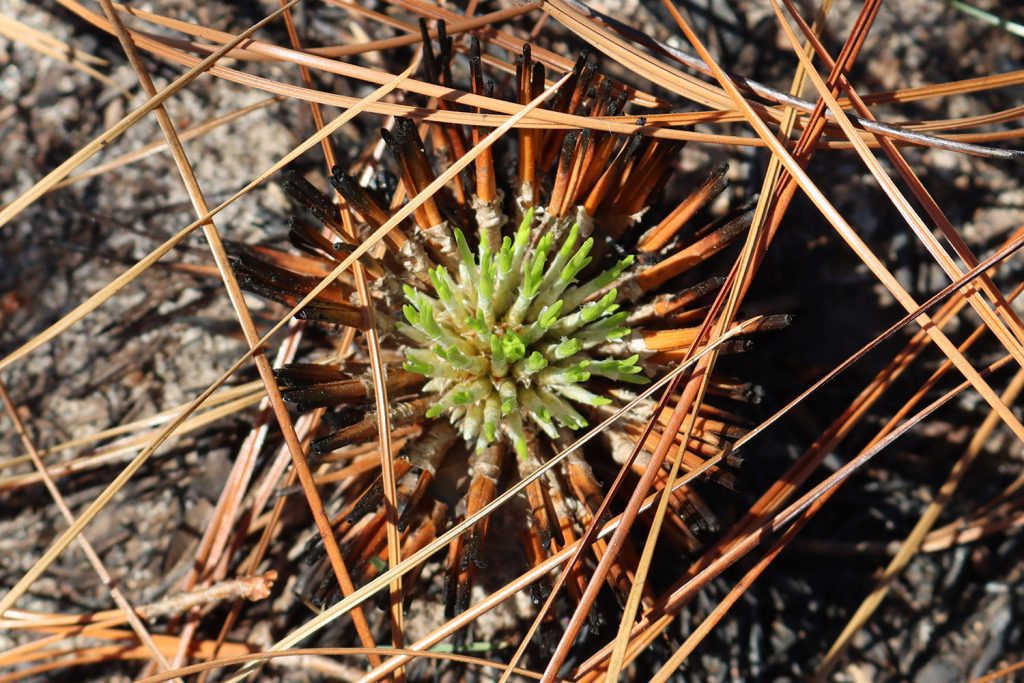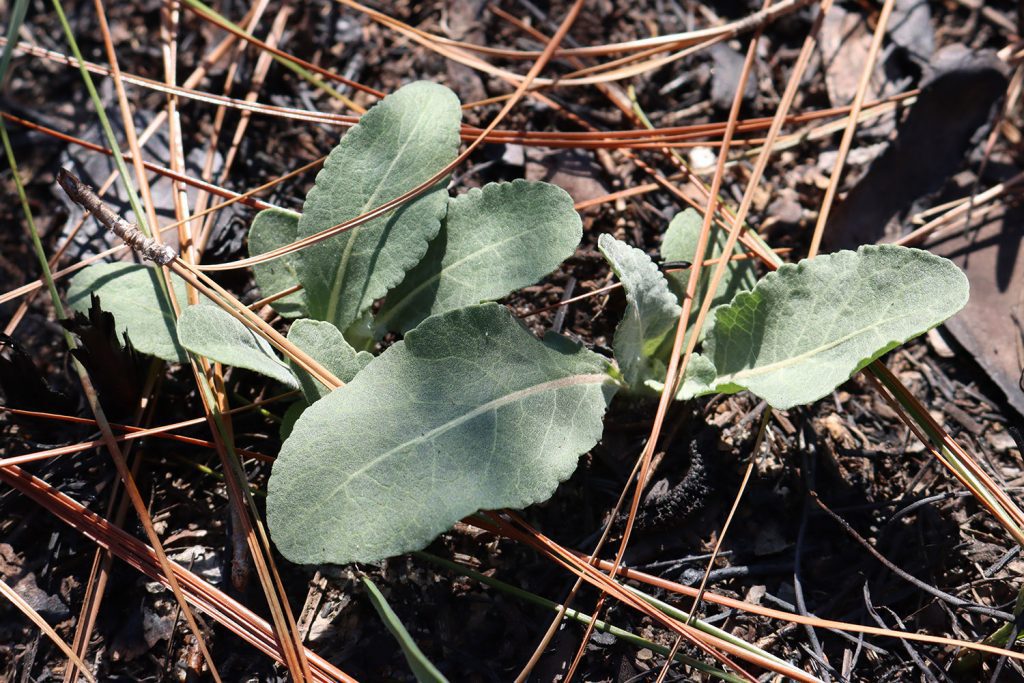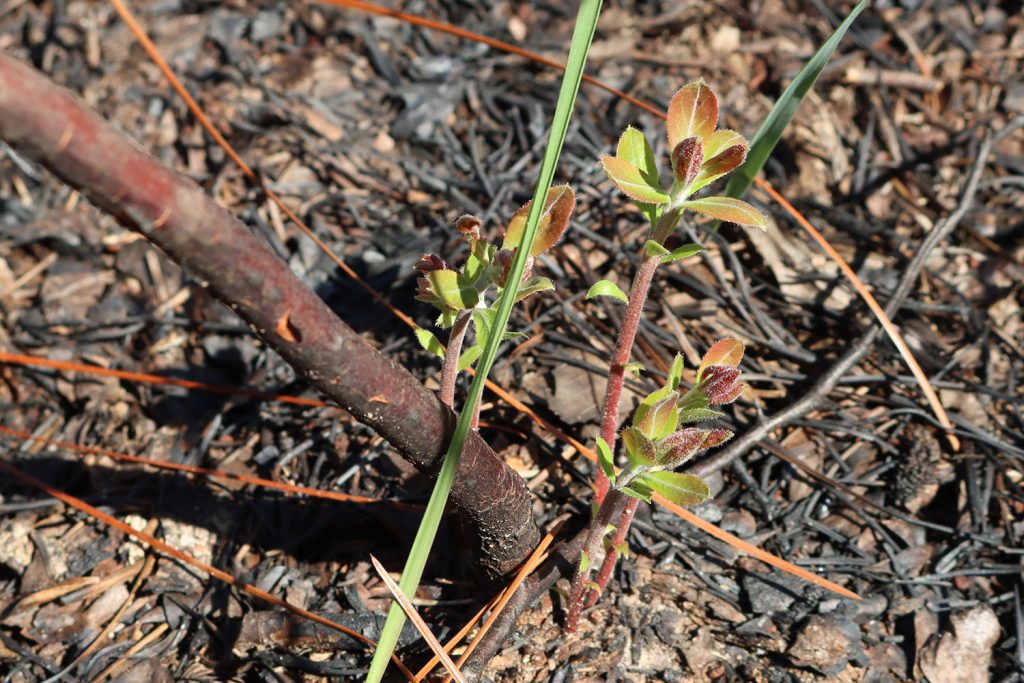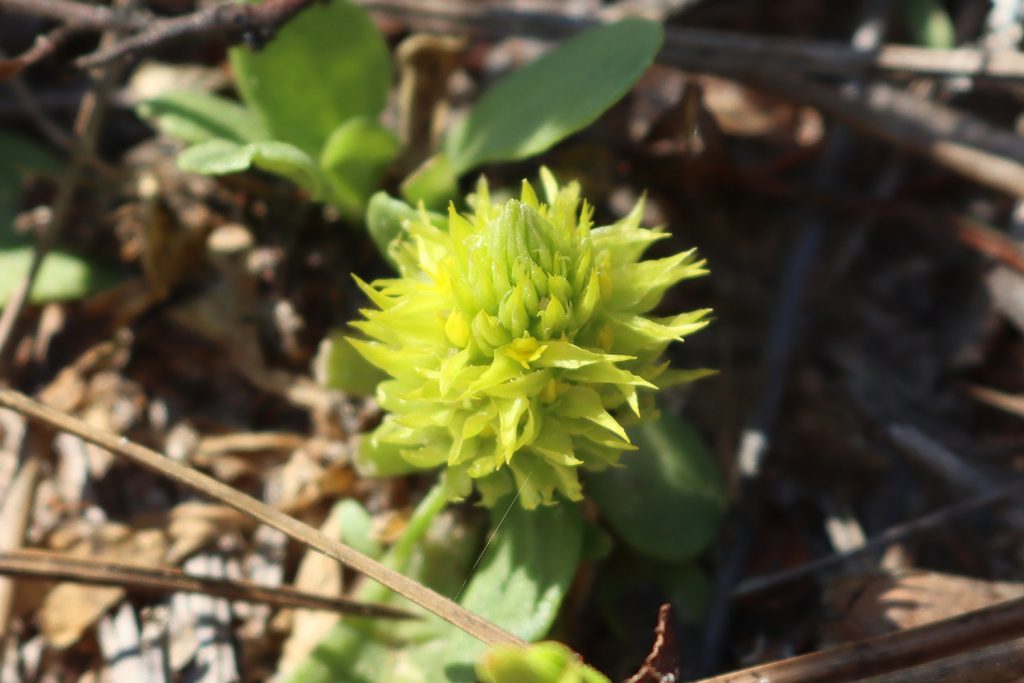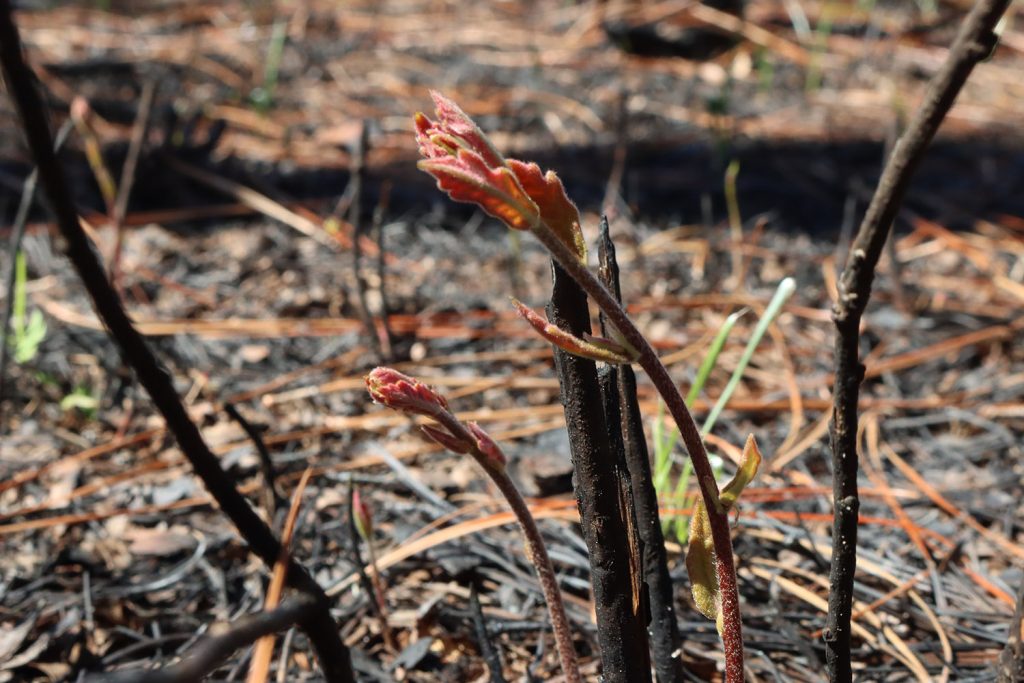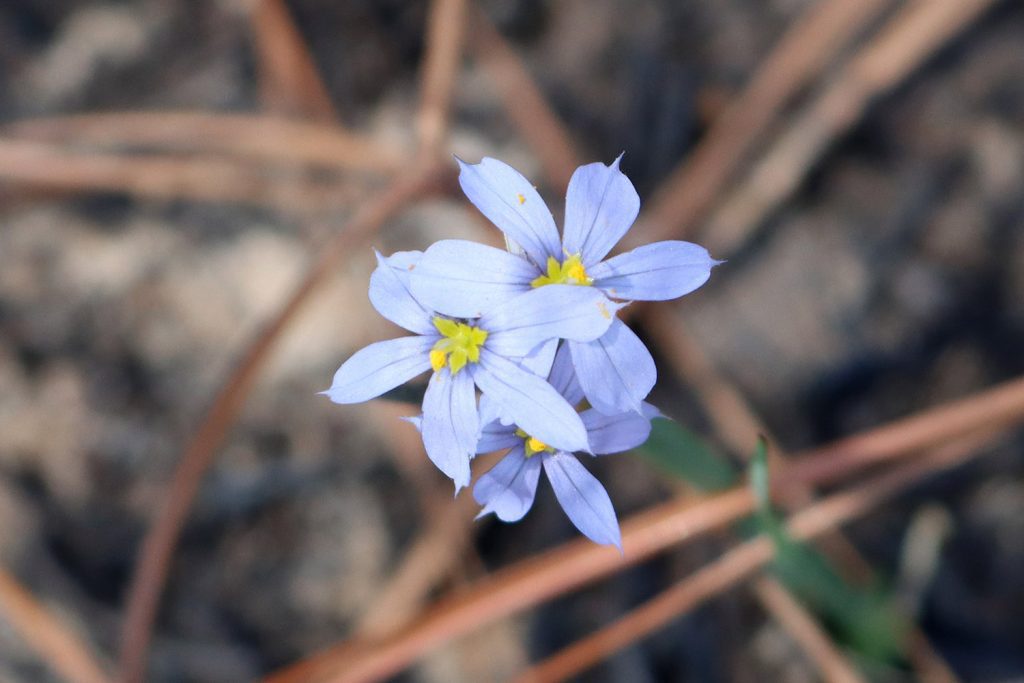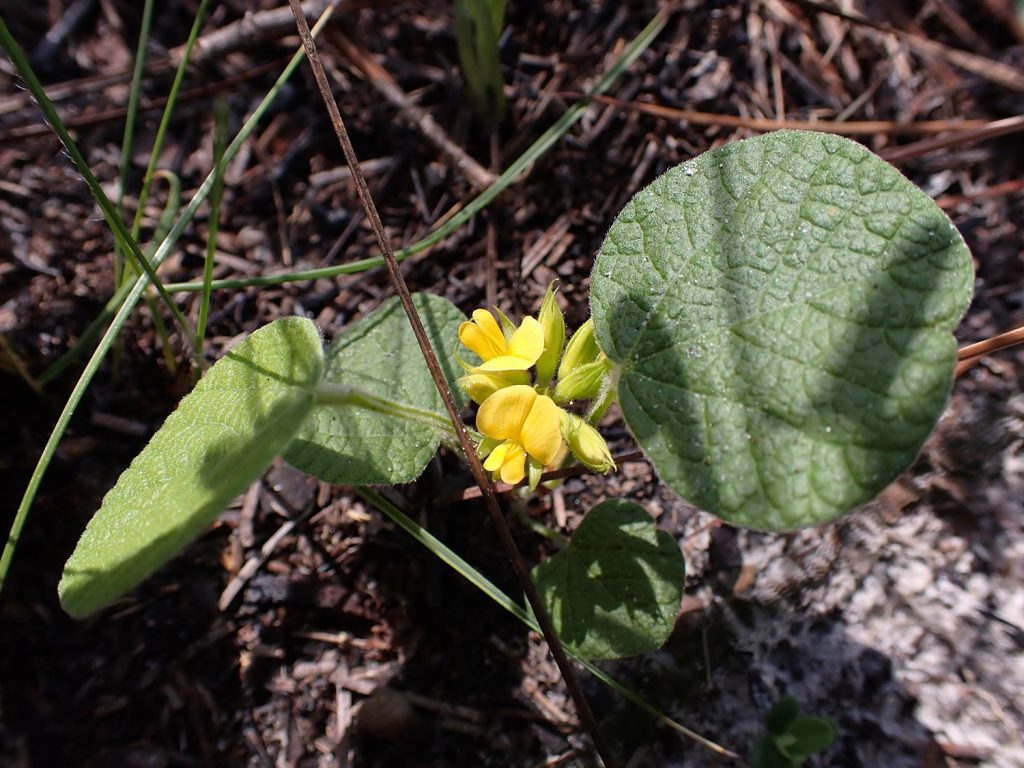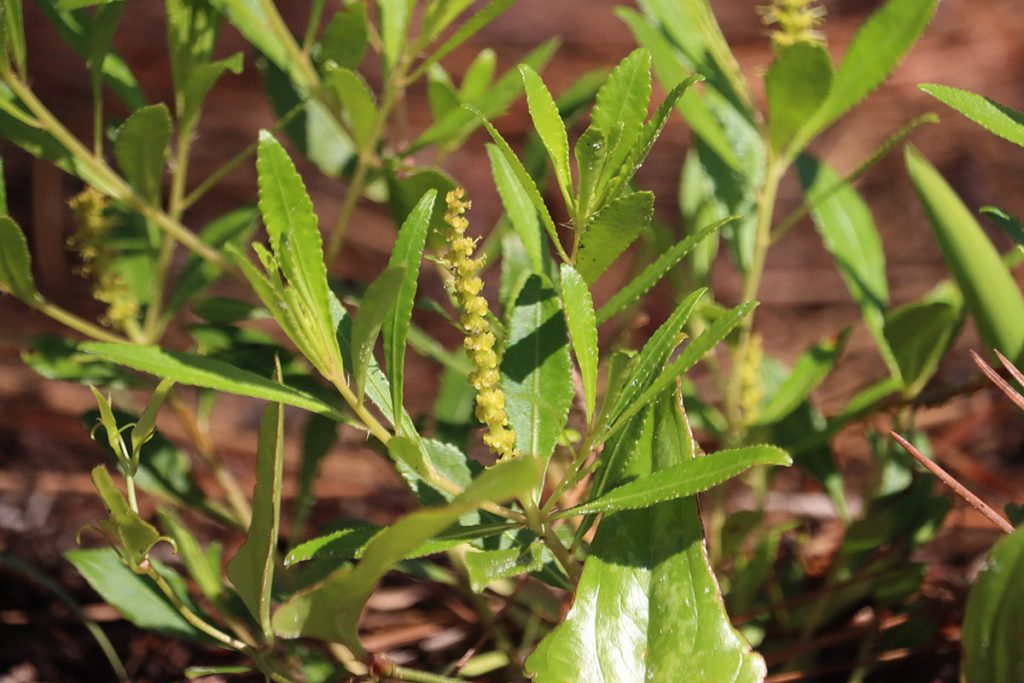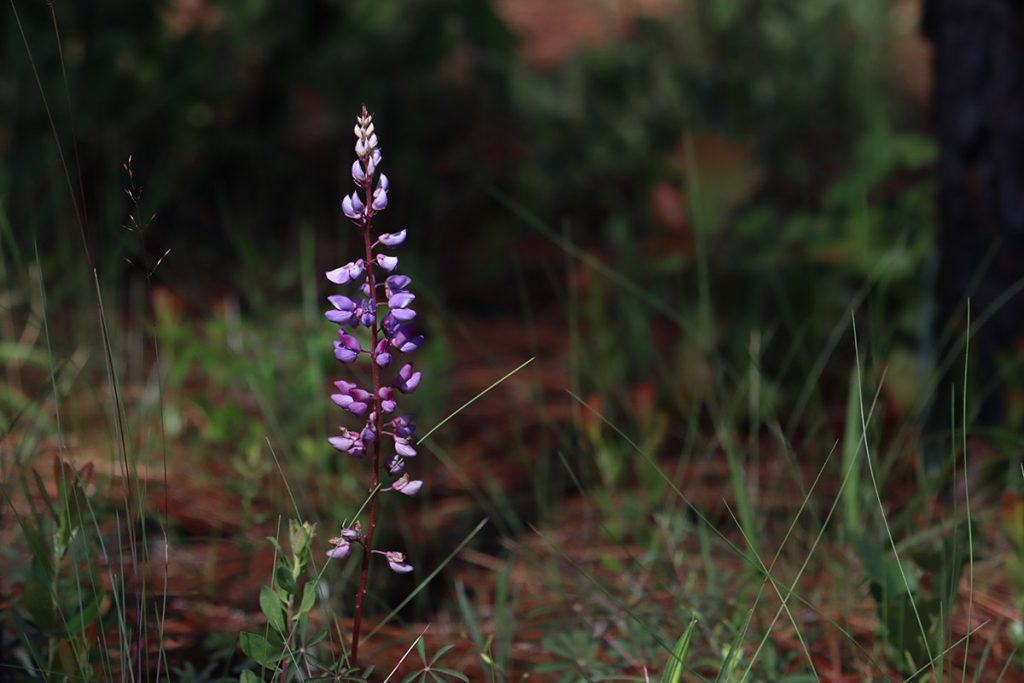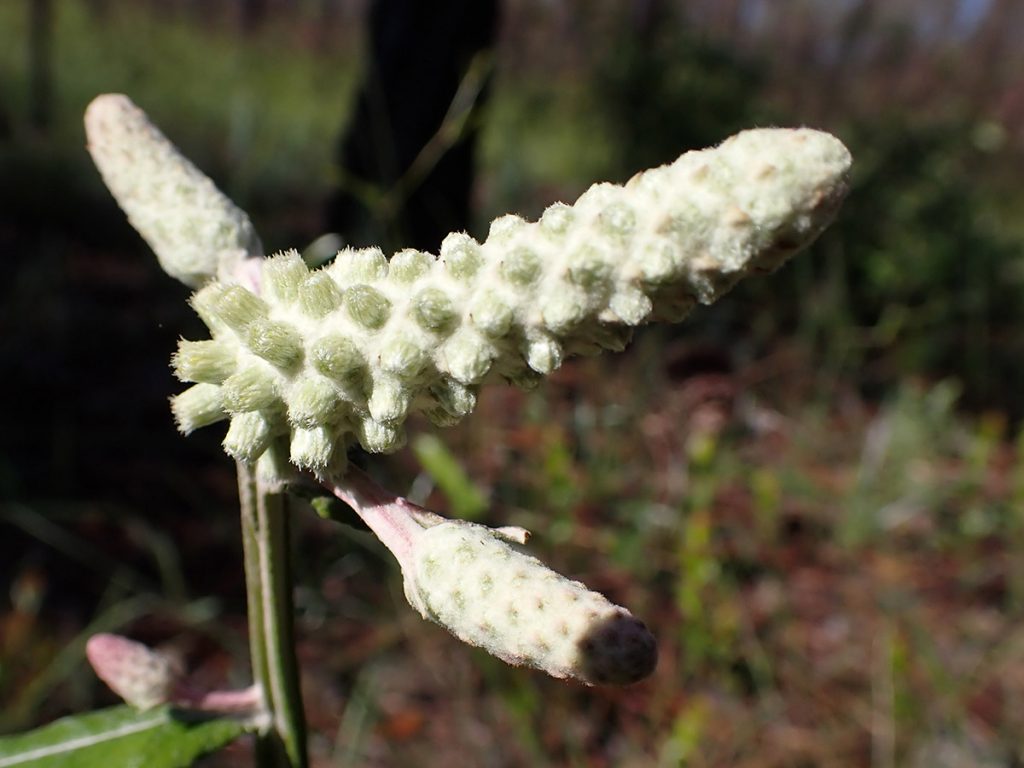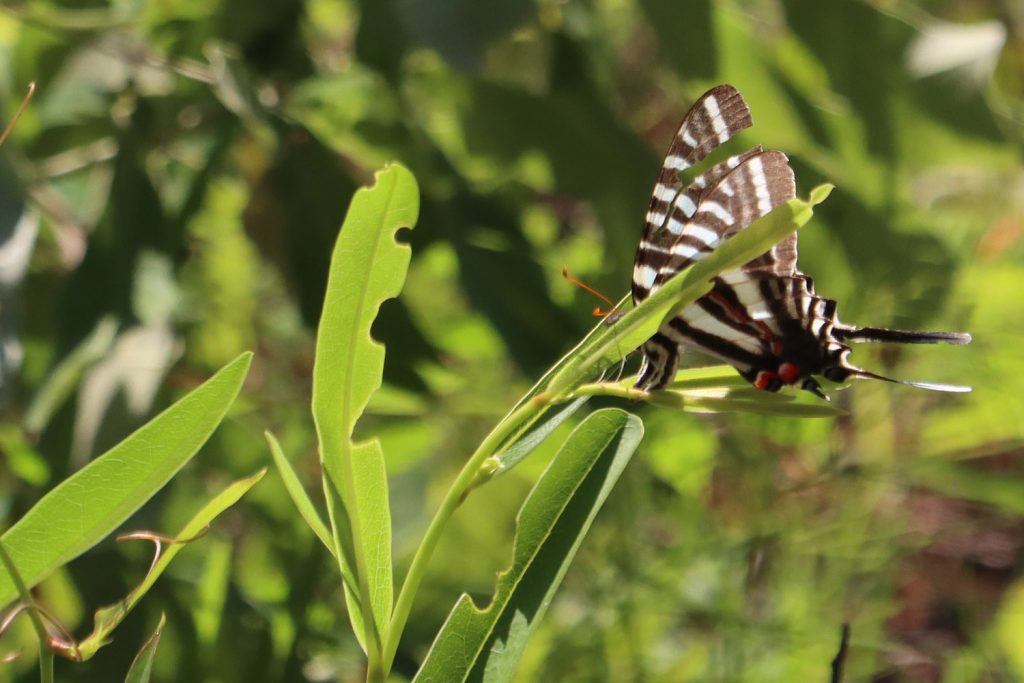I set the camera on the ground, and watch as the fire burns slowly through the grass towards me. By the end of the day, the ground will be black and empty. Fire hits the reset button in longleaf ecosystems; applied every 1-3 years, grasses and wildflowers cover more ground than do woody plants. In turn, this openness suits a host of animals that have evolved in this landscape. Frequent fire creates ecological balance here.
But might ecological balance locally contribute to an environmental imbalance globally? Watching the foliage turn to ash and smoke, we’re seeing carbon leave plants and enter the atmosphere. Regular prescribed fire is good for plants and animals, but might it be contributing to global climate change?
It’s a question that has interested researchers in recent decades. One of those researchers is Dr. Josh Puhlick, a silviculturist at the Jones Center at Ichauway, in south Georgia. Today the Jones Center is applying prescribed fire to several plots of longleaf forest. They’ve been at it for a little over a month, and so we can see different plots in different states of regrowth.
The Jones Center is a 29,000 acre laboratory, and these parcels of land are the foundation of the research conducted here. In these plots, Josh and his colleagues can see how flora and fauna respond to fire in different scenarios. They can experiment with different methods of sustainably harvesting timber from the forest. And they can also see how this ecosystem stores and releases carbon after a fire.
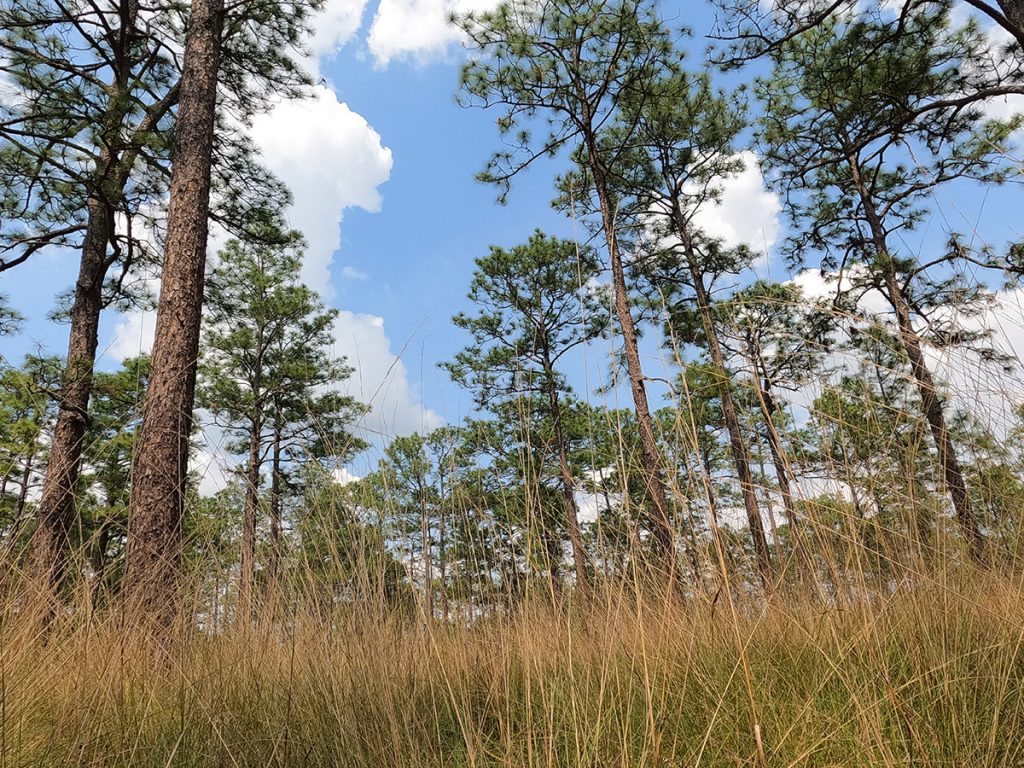
Can the longleaf pine habitat store more carbon than it burns away?
To many, longleaf pine ecosystems are more savannas than forests. The ideal habitat resembles a grassland, with pines standing a respectful distance from one another. When thinking about carbon in this habitat, I think of how few trees there are compared to other forest types.
About 58% of a plant’s matter is carbon. It would take a lot of wiregrass to store as much carbon as a tree that can grow to 120 feet tall, and that has a dense wooden trunk. Fire suppresses oaks and other hardwoods, not killing them, but keeping them small. Without fire, they become full sized trees, and so they would store much more carbon. Allowing this to happen would reduce the diversity of plant and animal species in the system, but might it not take more carbon out of the atmosphere?
And then there’s the smoke. Plants store carbon in their bodies in the form of carbohydrates. When fire burns away the grasses, palmettos, wildflowers, and the leaves of all the hardwoods, carbohydrates become carbon dioxide, a greenhouse gas.
Doing the carbon math on my fingers, it’s hard to see the longleaf ecosystem as carbon negative (meaning it takes in more carbon than it emits). But when the Jones Center and other researchers actually measure the carbon coming into and going out of the whole system, what do they find? The answer’s not as obvious.
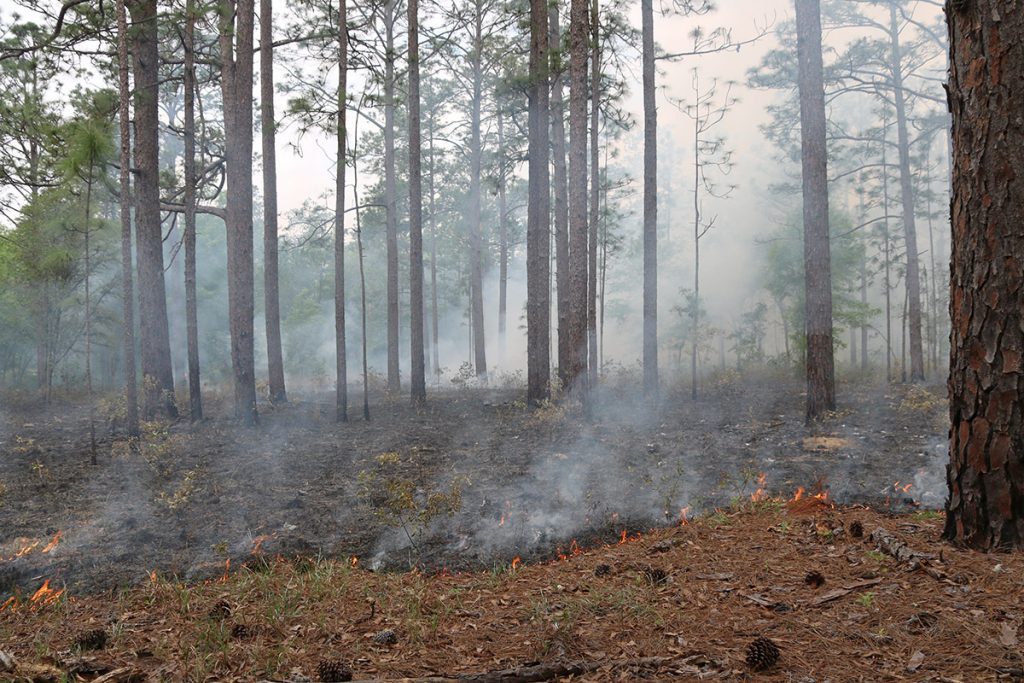
Frequent fire- less fuel, less smoke
A prescribed fire can look much different than the wildfires that make the news.
“A lot of people will think that these fires are massive fires,” says Josh Puhlick, “but with a prescribed fire, it’s really reducing a lot of the understory component. So not a very intense fire.”
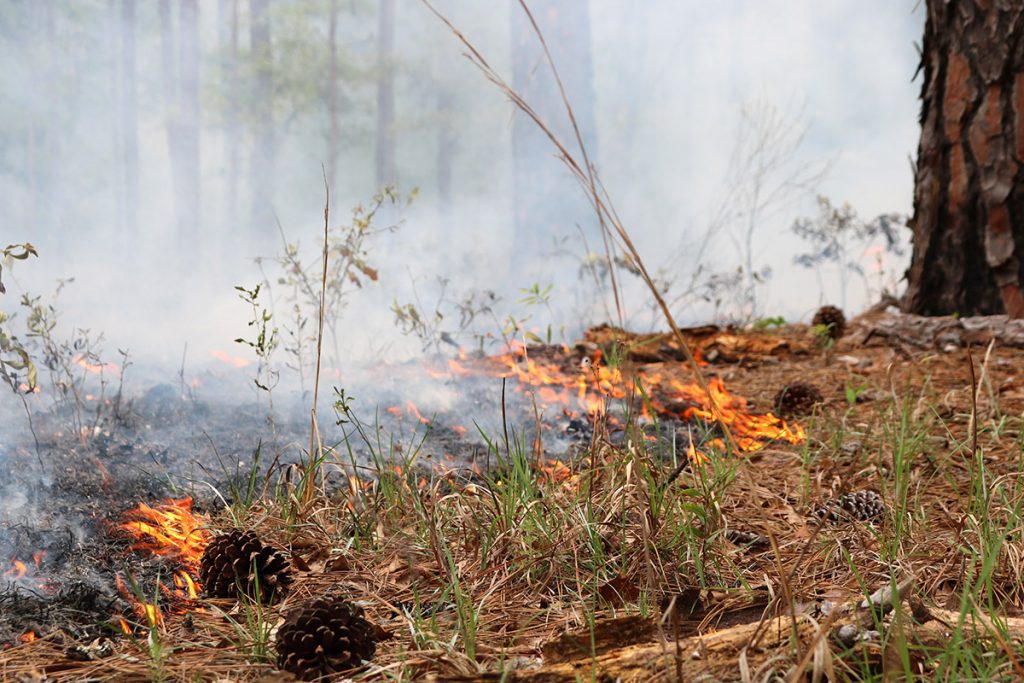
The intensity of the fire, and the amount of smoke, depends on how often the habitat is burned. The less often it sees fire, the more leaves and pine needles carpet the forest floor. When not checked by fire, hardwood shrubs—which are not so fire resistant— can become trees in time. If we don’t hit the reset button, a longleaf ecosystem shifts from grassy to woody.
Again, the woodier version of this forest stores more carbon. But it also stores more fuel. Florida is the lightning capital of the U.S., so wildfires are always a risk. To show us just how risky, Josh takes us to a plot that hasn’t seen fire in a long while.
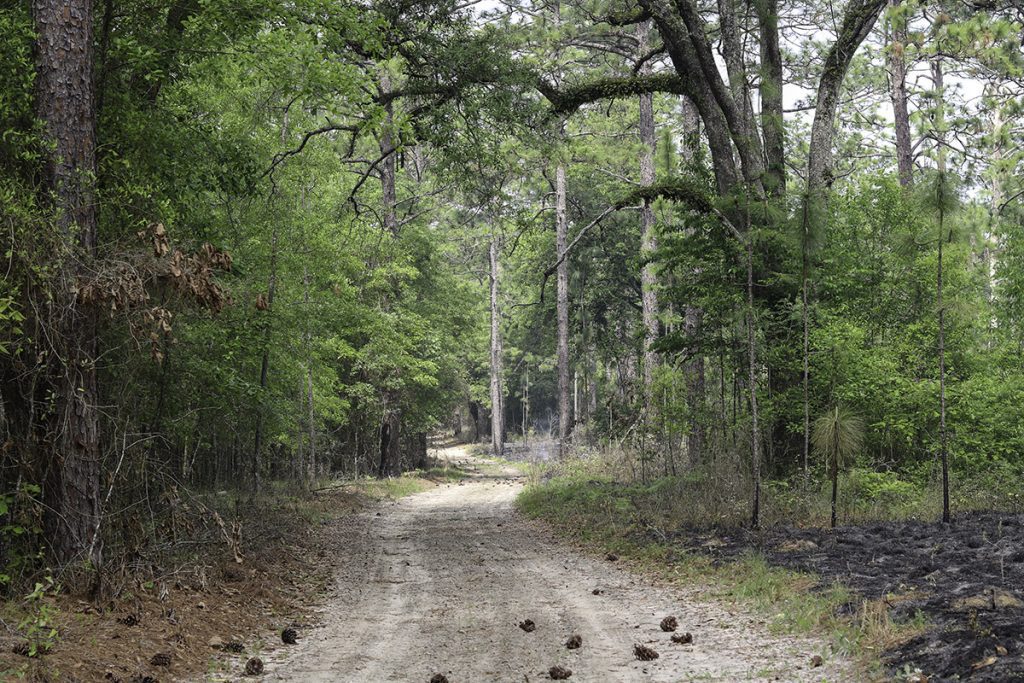
The fire exclusion plot
When tall hardwood trees replace grasses between the pines, we lose the open vistas of this ecosystem. “Right here in this position,” Josh says, “we can’t see over 100 hundred feet into the woods here. It’s very hard for us to see visually through this stand.”
We’re looking at a lot of stored carbon. We’re also looking at what Josh calls ladder fuels.
Regular fire creates a forest structure that keeps fire low to the ground. Its plants are either very tall or very short; flames won’t jump from a knee high clump of wiregrass to the top of a longleaf pine. In the forest plot where Josh has taken us, trees less fire resistant than longleaf now fill the space between the pines. In this mid-canopy there is the potential for catastrophe.
“If a fire was to occur in here, a wildfire,” Josh says, “then fire could move up through that mid-canopy position and then carry on into the crowns of those overstory longleaf pine. So you may have a high intensity crown fire which would release a lot of carbon and probably result in a lot of mortality of overstory pine.”
In other words, a lightning strike here could start a fire which could kill longleaf pines and release their carbon. So while a fire suppressed system could potentially store much more carbon than one regulated by fire, it also has the potential to release much more carbon.
Dr. Steven Brantley, an ecohydrologist at the Jones Center, compares it playing the stock market. A fire suppressed system is a high risk/ high reward investment in carbon storage, which he likens to Bitcoin. A fire maintained longleaf system is consistent, like Coca Cola (The Jones Center was founded and named after former Coca Cola executives). Even if you don’t have as high a potential return, you’re not as likely to lose it all with regular fire.
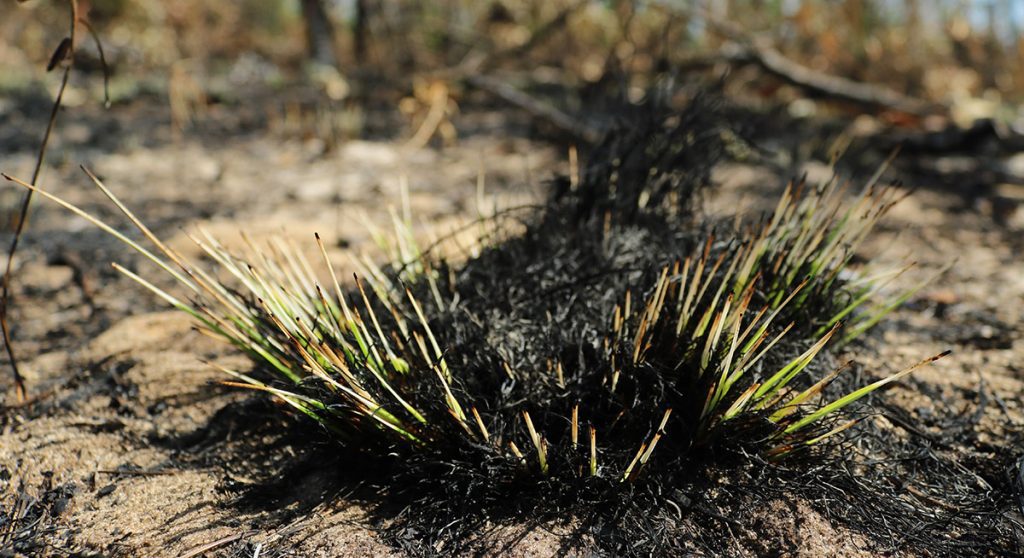
The longleaf savanna: a system that bounces back
So how quickly after a prescribed fire do we see a return on our investment?
On day zero, right after a burn— the land is black and empty. This, however, changes almost immediately. Because we’re in the lightning capital of the U.S., only the plants and animals best adapted to fire could thrive here. Wiregrass, a plant as important to this ecosystem as longleaf pine, can’t make seeds without fire. And the day after a burn, it starts to bring a little green back to the landscape.
That little bit of green on the forest floor is carbon taken from the atmosphere. Through photosynthesis, plants take water from the ground, carbon from the air, and sunlight to create carbohydrates. The more plants grow, the more carbon they take in.
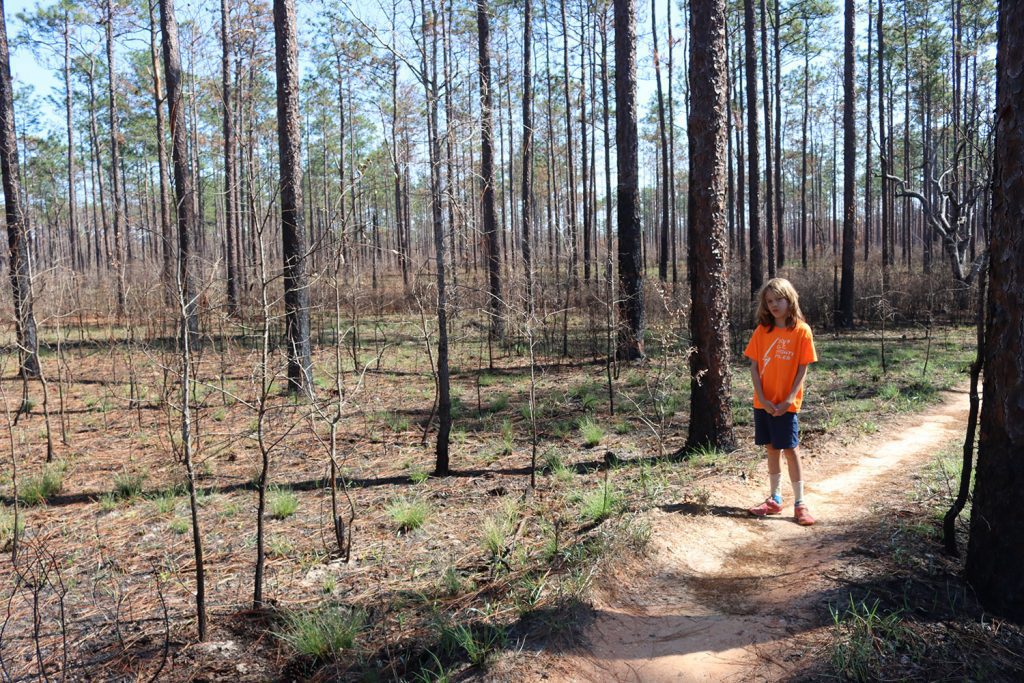
Within a few weeks, there are patches of green everywhere. In early March, my son and I walked a trail through a section of the Munson Sandhills that had burned 27 days earlier. Wiregrass was a few inches tall. Hardwood trees sprouted new growth from their roots. There were even a couple of wildflowers in bloom.
I revisited the same area another month and a half later. Multiple species of wildflowers were in bloom, and some had already started to go to seed. Oaks and other hardwoods were covered in young green leaves. What was black and empty just over two months ago was now full and green.
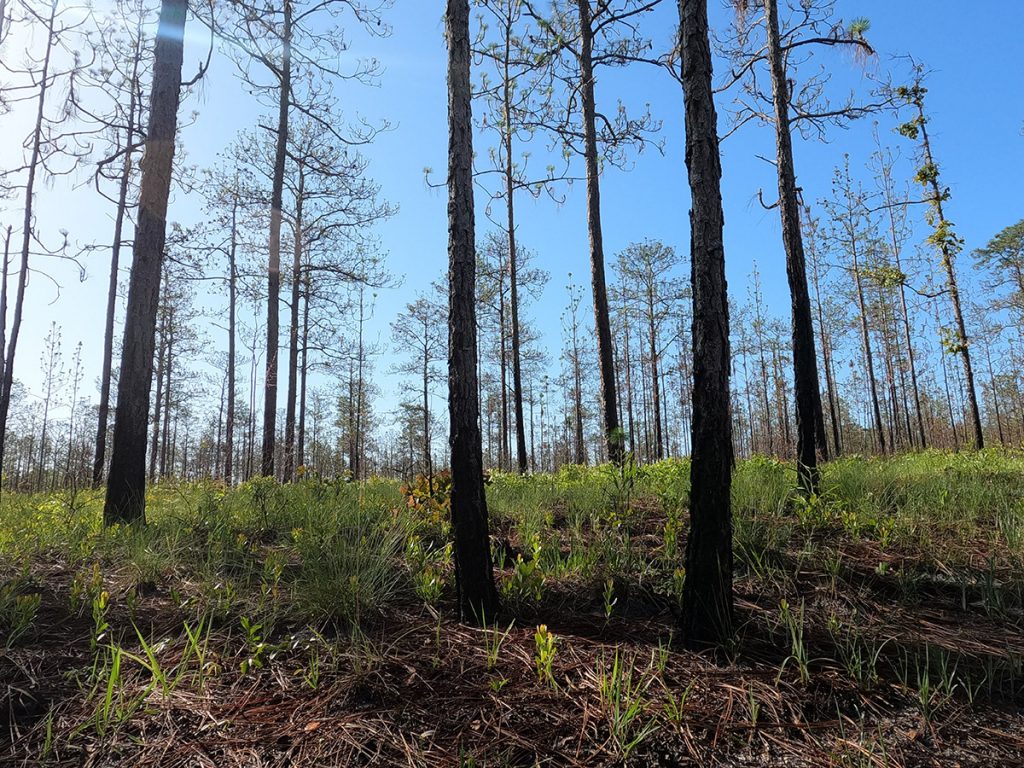
“In about 30 to 60 days,” Josh says, “the net carbon uptake of this system is similar to pre-fire levels. A very resilient system. It recovers really well after prescribed fire.”
All that new growth— and the carbon captured— was spurred by fire. That’s the carbon we can see. Next, let us consider the carbon we don’t see.
How much carbon is stored in longleaf soil?
Longleaf pine grows in sandy soils. Sandhills, like the Munson Sandhills or those in the Apalachicola Bluffs and Ravines, are ancient beach dunes— almost pure sand. In the Red Hills of Florida and Georgia, sand mixes with clay to create the Orangeburg sandy loam iconic of the region. The soil may be reddish orange, but it’s still more sand than clay.
The sand and clay by itself is just worn down bits of rock. A lot of what makes it so important to an ecosystem, or a gardener or a farmer, is its organic content.
To better understand the carbon content of a longleaf ecosystem, I talked to Dr. Yuch Ping Hsieh. Ping is a soil researcher at Florida A&M University who is partnering with Tall Timbers Research Station to study just this subject.
Keeping the soil bank account in the black
“Soil organic carbon,” says Ping Hsieh, “is a balance between the organic matter input and the decomposition rate of that matter.”
He likens soil organic carbon to a bank account. You deposit plant matter and the carbon stored in it, but its decomposition withdraws the carbon. If you deposit more than you withdraw— in other words, if you add content faster than it can decompose— you’re storing more carbon than you lose.
In most ecosystems, this process keeps a lot of carbon below ground. Says Josh Puhlick, “In a lot of forest ecosystems you can have as much as half of the total ecosystem carbon in the forest soil.”
Every leaf, pine needle, pinecone, and branch that falls on the ground is a deposit into the system. When a tree dies and falls over, both the log on the surface and the roots beneath are deposits.
However, if fire sweeps through an ecosystem every two years or so, a lot of that material burns. It would seem to be a hefty withdrawal. But what did Ping find when he checked the balance?
Like the Jones Center, Tall Timbers in Tallahassee has a fire exclusion plot. When he sampled soil from that plot and one burned frequently, this is what he found: “The soil organic matter level in the burn plot actually is higher than the unburned plot.”
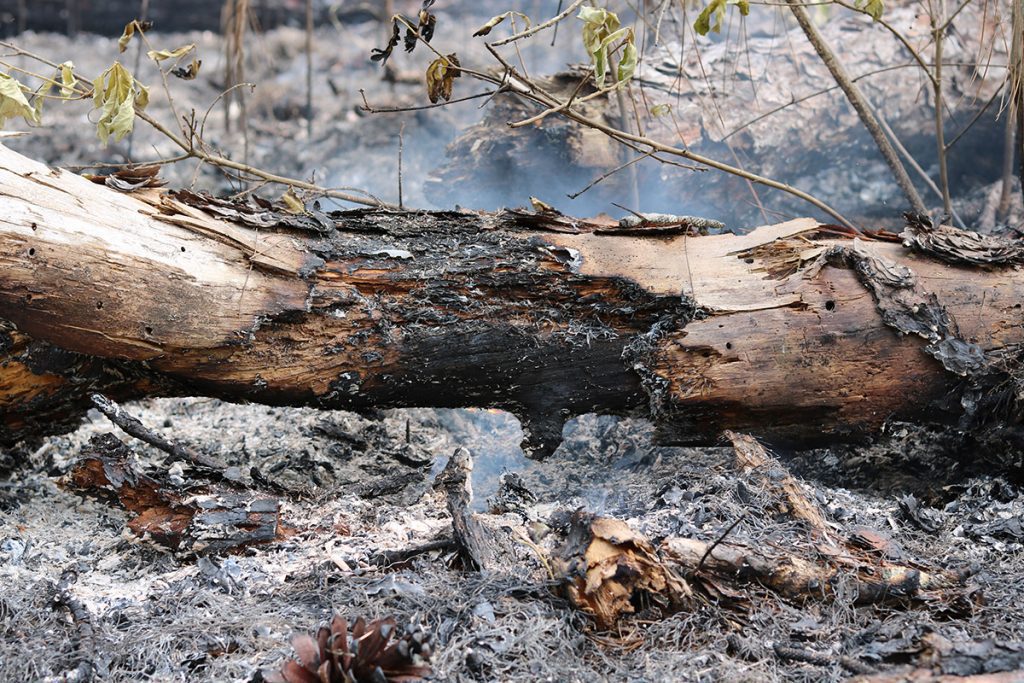
Black Carbon
A comparison between two single plots is a small sample size, Ping admits. But it’s not inconsistent with other work conducted in his lab. The reason might be something called black carbon.
Ryan Means, president of the Coastal Plains Institute, scoops a handful of sandy soil flecked with bits of black char. The area of the Munson Sandhills that burned back in February surrounds one of CPI’s striped newt repatriation ponds.
“You see for a good long time,” Ryan says, “for months and even years after a burn, you can see the freshly charred pine needles and twigs and pine bark and such, and rub it around your fingers and and see the black carbon there.”
Josh Puhlick and the Jones Center have been studying black carbon. “All the prescribed burning we do here results in partially combusted material, and some of that will make its way into the mineral soil and be stored there and persist over time.”
So a lot of material burns away, but a lot is only partially burned. And this might be a significant carbon source. A reason is that once organic material is charred, it decomposes much more slowly.
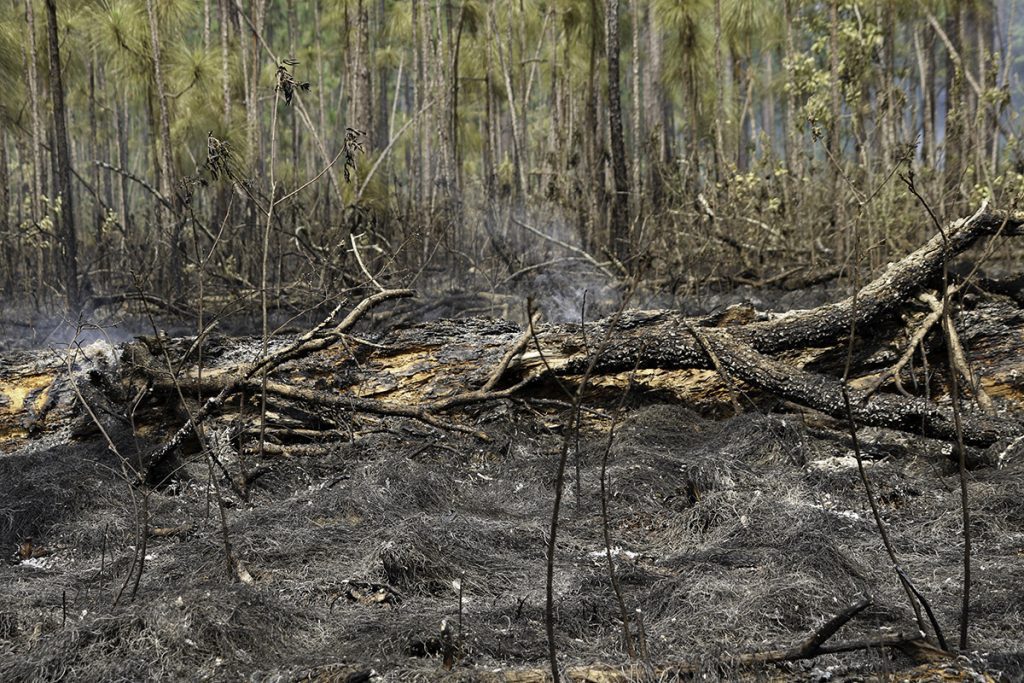
Biochar- a carbon sink and potential soil supplement
When I ask about black carbon, Ping lights up. He talks about Amazonian tribes hundreds of years ago, and how they would enrich their nutrient poor soils with logs they burned in pits. This allowed people to grow food in the Amazon basin, and sustain large populations. The practice stopped when Europeans arrived in the 1500s, and yet the soils there still contain this blackened biochar material.
One of Ping’s graduate students studied the decomposition rate of biochar over a two year period, comparing it with unburned material. “On average, if you harvest plant material like my student did and then bury into the soil— 3 to 4 years, all this material will go back to the atmosphere. And if you turn that raw material into black carbon, the mean resident time will increase at least 100 times.”
Biochar has a spongey quality that could benefit soil. Says Ping, “It’s very porous, so you can retain lots of moisture and retain lots of nutrients.”
The USDA cautions that while biochar does store carbon and can have considerable benefits for soil productivity, results have varied in different settings. Research into it is ongoing, though, and promises to be a game changer in agriculture and in the race to capture carbon.
Can we call a longleaf ecosystem a carbon sink?
Land managers don’t burn a longleaf forest with the intent to store carbon. Regular fire maintains the ecology of the system, prevents catastrophic wildfires, and improves water flow into the aquifer and nearby waterways. Humans are trying to best approximate what fire had once done naturally.
In their quest to maintain ecological equilibrium, they are indeed putting smoke into the atmosphere. That smoke can waft into inhabited areas, where it can affect air quality. It can be a tough thing for people with asthma and other respiratory conditions.
According to the American Lung Association, though, withholding fire from ecosystems poses the greater health risk. “The research shows that historical fire suppression policies are not sufficient for longer-term fire management. These strategies result in increased fire intensity and an increase in the number of people exposed during a single smoke event. This means that under the right conditions, prescribed fire can be an important tool to protect lung health from worse smoke impacts.”
One thing the ALA (as well as the EPA in a separate report) points out is that land managers can choose when and how to burn based on weather conditions. Fire ecologists continue to study methods to control the heat of a fire and the smoke it emits.
Ryan Means points out that much of the almost 600,000 acre Apalachicola National Forest burns at intervals of five years or greater (he also has a few things to say about the seasonality of fire, which we will follow up on in an upcoming post). During that longer interval, hardwoods grow larger and fill the forest with more fuel.
As for the carbon question, research is ongoing. Josh says that from what they’ve learned so far, a frequently burned longleaf system is at worst carbon neutral, and likely stores more carbon than it emits. The longleaf ecosystem evolved to thrive in a place where fire is a likelihood, and so in this setting, regular fire is its best carbon scenario.
This segment was produced in collaboration with NOVA. Major funding for the NOVA Science and Society Project is provided by the Corporation for Public Broadcasting. Additional funding is provided by the GBH Planet Future Fund.

